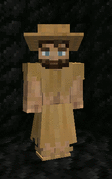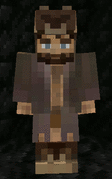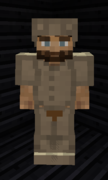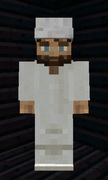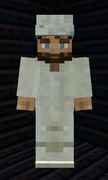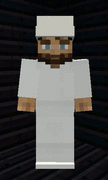Clothing
| This article needs to be updated to match TFC+'s newest version. It might not contain completely accurate information for the newest version. Please help by contributing.
Information: Recent changes to armor production and new clothing in .88. Article needs reorganising and move some points on crafting to Clothing Production. |
General

Clothing maintains body temperature by providing heat resistance or cold resistance bonuses when worn. Items such as hats, shirts, pants, socks, boots, sandals, robes, and coats can be crafted.
Outerwear like coats and robes, boots and sandals, leather armor, and straw or fur hats are worn in the armor slots. Cloth hats, shirts, pants, and socks are worn in the clothing slots (invisible slots to the right of the armor slots). If the player is wearing an item in the armor slot, the clothing slot cannot accessed. You must remove the outer layer to put on or take off clothing beneath it.
Raw materials used for clothing are Grass, Fur, Leather, Wool, Cotton, Linen, or Silk. Craft clothing pieces by holding raw materials in your hand and clicking on the ground. For all materials except Grass, you will also need a knife in your inventory. This will open a knapping interface that lets you cut the materials into pieces of the proper shape. The resulting pieces are assembled into completed clothing by sewing them together with a needle and thread. Grass clothing does not need to be sewn.
Clothing loses 1 point of durability per day when worn for any portion of a day (except the day it is created). Fur clothing doesn't degrade if the ambient temperature is below freezing the whole day. When you are on fire, clothing degrades every few seconds. Grass clothing degrades faster than cloth clothing while you are burning.
Effects on Body Temperature
Clothing can help the player manage their Body Temperature by giving resistance to heat or cold. Different types of clothing and different clothing materials giver different bonuses and penalties.
| Clothing Temperature Protection [Edit] | |||||||
|---|---|---|---|---|---|---|---|
| = | + | + | − + | − ++ | + | N/A | |
| = | + | + | − ++ | −− +++ | = | N/A | |
| + | + | + + | ++ | ++ + | + + | N/A | |
| + | + | + | −− +++ | −− ++++ | + | N/A | |
| N/A | −− +++ | N/A | −− ++++ | N/A | − ++ 1 | ++ | |
| N/A | N/A | N/A | −−− +++++ | N/A | ++ 1 | − ++ | |
| N/A | N/A | N/A | −− +++ | N/A | + | + | |
| − + | + | + | −− ++ | N/A | + | = | |
| Legend | |||||||
| − + Heat Resistance penalty/bonus | − + Cold Resistance penalty/bonus | = Neutral | |||||
- There are two varieties of fur hat: the generic fur hat that is sewn, and the animal's head hat, which is cut from the fur using a knife. They are identical in protection.
Wetness
Rain, water and sweating can turn clothing wet, which reduces or removes its heat resistance bonuses. Wet clothing also directly effects Body Temperature. This means entering the water in the cold climates can be hazardous, so it may be a good idea to remove clothing before swimming. This also makes sweating in cold temperatures dangerous as well, and the player must be careful to not overexert in cold environments.
If a player is in the rain their outermost layer of clothing will gain the Damp status. Armor in the outermost slot will keep Clothing beneath it dry. Damp clothing loses one level of temperature resistance. In the tooltip, one + or - symbol will show blue instead of white. As long as the player is wearing damp clothes on either their upper or lower body, the ambient temperature will feel 1 level colder. If they wear damp clothes on both upper and lower body, they will feel 2 levels colder.
If the player enters water their clothing will gain the Soaked status. If they stand in waist-high water, only clothing on the lower body will become soaked. If the player enters water more than 1 block deep, clothing on both the upper and lower body will be soaked. Soaked clothing loses *all* temperature resistance. The tool tip will show all + or - symbols as blue instead of white. As long as the player wears soaked clothing on their upper body, the ambient temperature will feel 2 levels colder. If their lower body is also soaked or damp, they will feel 3 levels colder.
Clothing will slowly dry on its own if the player is wearing it as long as the temperature is above freezing. If the inventory GUI is open, the drying process is paused. To dry clothing faster, it can be placed in the input slot of a lit firepit or forge, or hanged on a Drying Rack during clear weather. Note that drying racks do not work in extreme humidity environments
Dyeing
Cotton, Linen, Silk and Wool Clothing can be colored with liquid Dyes made from Weld Root, Woad Leaves, Madder Root, Ash, or Ink Markings placed in a barrel of Tannin. Clothing made of Leather or Fur are not able to be dyed. Clothing can be dyed more than once and in different dyes to achieve a wide range of colors.
| Red Dye (Madder Root) | Yellow Dye (Weld Root) | Blue Dye (Woad Leaves) | |||||||||||||||||||||||||||||||||
|---|---|---|---|---|---|---|---|---|---|---|---|---|---|---|---|---|---|---|---|---|---|---|---|---|---|---|---|---|---|---|---|---|---|---|---|
|
|
| |||||||||||||||||||||||||||||||||
| White Dye (Ash) | Black Dye (Ink Marking) | ||||||||||||||||||||||||||||||||||
|
| ||||||||||||||||||||||||||||||||||
To apply Dye to Clothing, place the clothing in a Barrel of Dye and seal it. After 4 hours, the Clothing will absorb 250 mB of Dye and take on some color. It will absorb another 250 mB of Dye and become more strongly colored every 4 hours until the Barrel is empty or unsealed.
One run in White Dye lightens the color of Clothing by 20% of pure white. This means that five runs in white Dye (20 hours) will make any clothing as light as possible (back to the normal raw color of that cloth). One run (4 hours) in Black Dye darkens the colors of Clothing by 50% of its current color. This means clothing will darken quickly, but never get to complete black. Each run in Red/Yellow/Blue Dye will multiply the current color with the dye's color, so it also goes toward the color quickly but never fully.
Note: Liquid Dyes are not to be confused with Pigments, which are powders made by grinding certain materials in a quern, and are used to color Clay Vessels, Glass Blocks, Fireworks, and Carpets.
Armor
- Main article: Armor
All articles of clothing provide some Armor with various degrees of coverage and protection based on clothing type and material.
As a basic guide, here is a list of how much protection clothing will provide from weakest to strongest:
- Grass/Straw clothing provides next to no protection,
- Linen and Cotton clothing provide only token protection,
- Woolen clothing provides a tiny amount more than Linen and Cotton,
- Silk provides poor but noteworthy protection,
- Leather provides appreciable Damage Protection (especially Crush protection which fiber clothing provides little of),
- Fur from deer or mouflon is all round slightly superior to leather,
- Wolf fur provides good all-round protection and is superior to generic fur,
- Bear fur provides respectable damage protection and has the most protection for non-metal clothing.
For more detailed info, see the main article on Armor.
Materials
Grass clothing gives heat resistance with the exception of the grass cloak, which gives cold resistance. Craft grass clothing by right-clicking the ground while holding holding 5 or more straw in your hand. Grass clothing does not require sewing. These items have lower durability than other clothing, but are easy to make.
Fur clothing gives cold resistance. Craft fur clothing pieces by right-clicking the ground while holding 1 or more fur in your hand while you have a knife in your inventory. Fur clothing pieces must be sewn together to create finished clothes.
Leather Clothing gives a small amount of armor and cold resistance and is worn in the middle body slots. Craft leather clothing pieces by right-clicking the ground while holding 1 or more leather in your hand while you have a knife in your inventory. Leather clothing pieces must be sewn together to create finished leather clothes.
Wool clothing gives cold resistance bonuses and heat resistance penalties. There is an additional heat resistance penalty for wearing multiple wool items. Craft wool clothing pieces by right-clicking the ground while holding 1 or more wool cloth in your hand while you have a knife in your inventory. Wool cloth is woven from wool yarn on the loom. Wool clothing pieces must be sewn together to create finished clothes.
Linen clothing gives mixed cold and heat resistance bonuses and penalties. Craft Linen clothing pieces by right-clicking the ground while holding 1 or more Linen cloth in your hand while you have a knife in your inventory. Linen cloth is woven from Linen string on the loom. Linen clothing pieces must be sewn together to create finished clothes.
Silk clothing gives mixed cold and heat resistance bonuses. Craft Silk clothing pieces by right-clicking the ground while holding 1 or more Silk cloth in your hand while you have a knife in your inventory. Silk cloth is woven from Silk string on the loom. Silk clothing pieces must be sewn together to create finished clothes.
-
Grass
-
Fur
-
Leather
-
Wool
-
Linen
-
Silk
Obtaining
Hats
Fur and Straw hats and the Leather Cap are worn in the outer head slot (like helmets). Cotton, Linen, Silk, and Wool hats are worn in the inner head slot. The Straw Hat is knapped from Straw. It provides Shade and has more durability than other grass clothing. It also has a variant style if crafted in Asia. Other hats are crafted by cutting and sewing together two Hat Pieces made of Bear Fur, Cotton, Fur, Leather, Linen, Silk, Wolf Fur, or Wool. The Animal Head Hats are not knapped or sewn, but are crafted with a Knife and a Large Bear Fur or Wolf Fur.
Walking without a hat under hot sunny weather will cause a hot temperature penalty to the player.
| Straw Hat | Hat Pieces | ||||||||||||||||||||||||||||||||||||||||||||||||||||||
|---|---|---|---|---|---|---|---|---|---|---|---|---|---|---|---|---|---|---|---|---|---|---|---|---|---|---|---|---|---|---|---|---|---|---|---|---|---|---|---|---|---|---|---|---|---|---|---|---|---|---|---|---|---|---|---|
|
|
|
| Hats | Animal Head Hat | ||||||||||||||||||||||||||||
|---|---|---|---|---|---|---|---|---|---|---|---|---|---|---|---|---|---|---|---|---|---|---|---|---|---|---|---|---|---|
|
|
|
Shirts
Shirts are worn in the inner chest slot, except the Leather Tunic, which is worn in the outer chest slot (like a breastplate or coat). The Grass Shirt is knapped from Straw, and the other shirts are crafted by cutting and sewing together two Shirt Body pieces and two Shirt Sleeves made from Cloth.
| Grass Shirt | Shirt Sleeves | ||||||||||||||||||||||||||||||||||||||||||||||||||||||
|---|---|---|---|---|---|---|---|---|---|---|---|---|---|---|---|---|---|---|---|---|---|---|---|---|---|---|---|---|---|---|---|---|---|---|---|---|---|---|---|---|---|---|---|---|---|---|---|---|---|---|---|---|---|---|---|
|
|
|
| Shirt Body | Shirt | |||||||||||||||||||||||||||||||||||||||||||
|---|---|---|---|---|---|---|---|---|---|---|---|---|---|---|---|---|---|---|---|---|---|---|---|---|---|---|---|---|---|---|---|---|---|---|---|---|---|---|---|---|---|---|---|---|
|
|
|
T-Shirts are worn in the inner chest slot. T-Shirts require less Cloth to make compared to full shirts and are better suited to warmer climates. They are crafted by sewing together two Shirt Body Pieces and two Short Shirt Sleeves. Two Short Shirt Sleeves can be obtained by crafting one Shirt Sleeve with a knife.
| Short Shirt Sleeves | T-Shirt | ||||||||||||||||||||||||||||
|---|---|---|---|---|---|---|---|---|---|---|---|---|---|---|---|---|---|---|---|---|---|---|---|---|---|---|---|---|---|
|
|
|
Sleeveless Shirts are worn in the inner chest slot. Sleeveless Shirts require less materials to make compared to full shirts and are better suited to warmer climates. They are crafted by sewing together two Shirt Body Pieces.
| Sleeveless Shirt | ||||||||||||||||
|---|---|---|---|---|---|---|---|---|---|---|---|---|---|---|---|---|
|
|
Coats
Coats are worn in the outer chest slot and are crafted by cutting ans Clothing Production#Sewing together one Coat Front, one Coat Back, and two Shirt Sleeves. They can be made of Cotton, Bear Fur, Fur, Linen, Silk, Wolf Fur, or Wool.
| Shirt Sleeves | Coat Back | ||||||||||||||||||||||||||||||||||||||||||||||||||||||
|---|---|---|---|---|---|---|---|---|---|---|---|---|---|---|---|---|---|---|---|---|---|---|---|---|---|---|---|---|---|---|---|---|---|---|---|---|---|---|---|---|---|---|---|---|---|---|---|---|---|---|---|---|---|---|---|
|
|
|
| Coat Front | Coat | |||||||||||||||||||||||||||||||||||||||||||
|---|---|---|---|---|---|---|---|---|---|---|---|---|---|---|---|---|---|---|---|---|---|---|---|---|---|---|---|---|---|---|---|---|---|---|---|---|---|---|---|---|---|---|---|---|
|
|
|
Robes
Robes are worn in the outer chest slot. They are crafted by Sewing together two Coat Backs and two Shirt Sleeves. They can be made of Cotton, Linen, Silk, or Wool. Robes reduce the player's sprinting speed by 15% of normal sprinting speed.
| Shirt Sleeves | Coat Back | ||||||||||||||||||||||||||||||||||||||||||||||||||||||
|---|---|---|---|---|---|---|---|---|---|---|---|---|---|---|---|---|---|---|---|---|---|---|---|---|---|---|---|---|---|---|---|---|---|---|---|---|---|---|---|---|---|---|---|---|---|---|---|---|---|---|---|---|---|---|---|
|
|
|
| Robe | ||||||||||||||||
|---|---|---|---|---|---|---|---|---|---|---|---|---|---|---|---|---|
|
|
Cloaks
Cloaks are worn on the back slot and are knapped from straw, cloth or fur.
| Cloak | |||||||||||||||||||||||||||
|---|---|---|---|---|---|---|---|---|---|---|---|---|---|---|---|---|---|---|---|---|---|---|---|---|---|---|---|
|
|
Pants
Pants are worn in the inner legs slot and are made by cutting and Clothing Production#Sewing together two Pants Pieces from cloth or fur.
| Pants Piece | Pants | |||||||||||||||||||||||||||||||||||||||||||
|---|---|---|---|---|---|---|---|---|---|---|---|---|---|---|---|---|---|---|---|---|---|---|---|---|---|---|---|---|---|---|---|---|---|---|---|---|---|---|---|---|---|---|---|---|
|
|
|
Shorts are worn in the inner legs slot and are made by sewing together two Shorts Pieces. A Shorts Piece can be made by crafting a Pants Piece with a knife. This also produces a cloth scrap of the same type as the pants piece.
| Shorts Piece | Shorts | ||||||||||||||||||||||||||||
|---|---|---|---|---|---|---|---|---|---|---|---|---|---|---|---|---|---|---|---|---|---|---|---|---|---|---|---|---|---|
|
|
|
Skirts
Skirts are worn in the middle leg slot. They are crafted by cutting two Skirt Pieces from cloth and then sewing them together. The grass skirt is knapped from straw.
| Skirt Piece | Skirt | |||||||||||||||||||||||||||||||||||||||||||
|---|---|---|---|---|---|---|---|---|---|---|---|---|---|---|---|---|---|---|---|---|---|---|---|---|---|---|---|---|---|---|---|---|---|---|---|---|---|---|---|---|---|---|---|---|
|
|
|
| Grass Skirt | |||||||||||||||||||||||||||
|---|---|---|---|---|---|---|---|---|---|---|---|---|---|---|---|---|---|---|---|---|---|---|---|---|---|---|---|
|
|
Socks
Socks and Foot Wraps are worn in the inner feet slot. Straw Foot Wraps are made by knapping Straw. Other socks are made by cutting and sewing together two Sock Cloths from Cotton, Linen, Silk, or Wool. Linen socks will multiply the player's total movement speed by 102% (including bonuses from footwear, the Wooden Staff and Roads) when worn with Fur or Leather Boots.
| Straw Socks | Sock Cloth | ||||||||||||||||||||||||||||||||||||||||||||||||||||||
|---|---|---|---|---|---|---|---|---|---|---|---|---|---|---|---|---|---|---|---|---|---|---|---|---|---|---|---|---|---|---|---|---|---|---|---|---|---|---|---|---|---|---|---|---|---|---|---|---|---|---|---|---|---|---|---|
|
|
|
| Socks | ||||||||||||||||
|---|---|---|---|---|---|---|---|---|---|---|---|---|---|---|---|---|
|
|
Footwear
Footwear is worn in the outer feet slot and adds a bonus to base movement speed.
Grass Sandals are knapped from Straw and give +5% to base movement when the player is on sand, otherwise they give +2%. Leather Sandals are crafted by cutting and sewing together one Leather Boot Soles and two Leather Straps. They give +10% to movement on sand, otherwise they give +5%.
Walking barefoot on hot surfaces (metal, sand, stone) exposed to the sun above 30°C or above will give the player a hot temperature penalty
Boots are made by cutting and sewing together one Boot Soles and two Boot Tops from Leather or Fur. Boots give +2% to movement on sand, otherwise Fur Boots give +5% and Leather Boots give +10%. When Boots are worn with Linen Socks, total movement (including bonuses from Footwear, the Wooden Staff, and Roads) is multiplied by 102%. Fur Boots will ignore the speed penalty caused by snow.
Note: Armor boots (made from metal) are not Clothing, and do not have speed or temperature bonuses.
| Grass Sandals | Boot Soles | ||||||||||||||||||||||||||||||||||||||||||||||||||||||
|---|---|---|---|---|---|---|---|---|---|---|---|---|---|---|---|---|---|---|---|---|---|---|---|---|---|---|---|---|---|---|---|---|---|---|---|---|---|---|---|---|---|---|---|---|---|---|---|---|---|---|---|---|---|---|---|
|
|
|
| Boot Tops | Boots & Sandals | |||||||||||||||||||||||||||||||||||||||||||||||||||||||||||||
|---|---|---|---|---|---|---|---|---|---|---|---|---|---|---|---|---|---|---|---|---|---|---|---|---|---|---|---|---|---|---|---|---|---|---|---|---|---|---|---|---|---|---|---|---|---|---|---|---|---|---|---|---|---|---|---|---|---|---|---|---|---|---|
|
|
|
Repair
Clothes will lose durability points from normal wear, from fire, and from protecting the player from damage. Clothing can be repaired by Sewing on a Cloth Scrap or Tiny Fur Scrap of the same material. You cannot repair Leather Clothing. Large Clothing items (ex: Robe, Coat) will take more scraps to repair fully than smaller Clothing items (ex: Socks, Hat).
To repair a damaged item, hold a Cloth Scrap or Tiny Fur Scrap and ![]() Right Click on a solid block to open the Sewing interface. Place the damaged item into an input slot along with a scrap of matching material.
Right Click on a solid block to open the Sewing interface. Place the damaged item into an input slot along with a scrap of matching material.
| Repair | ||||||||||||||||
|---|---|---|---|---|---|---|---|---|---|---|---|---|---|---|---|---|
|
|
History
| Beta | ||
|---|---|---|
| 80.12 | Added body temperature | |
| Added 4 new clothing slots on the player. | ||
| Added sewing mechanic for creating clothes. | ||
| Added wool, linen, or silk cloth can be sewn into shirts, socks, pants, hats, and coats. | ||
| Added bear and wolf furs, which can be sewn into coats, hats, and boots. | ||
| Added dyeing system for clothes and 3 new crops to make dyes for clothing. | ||
| 80.18 | Added Regional variant of the straw hat | |
| Added Robes | ||
| Coats made longer and more animated when the player moves | ||
| 81.6 | Walking through snow is faster with wolf or bear fur boots on | |
| 82.0 | Added Cotton Clothing | |
| Added Cloth Patches | ||
| Added Armor Values to Clothing | ||
| If wearing two layers of clothing in rain, the inner layer won't get damp | ||
| 82.2 | Clothing Wetness has been added back to game | |
| All footwear provides a minimum movement bonus of +2% on any terrain | ||
| Straw Hats now provide shade in addition to their normal heat protection | ||
| GUI for the player inventory now has visible back slot and 4 placeholder slots for future Clothing | ||
| Clothing can now be put on by shift clicking (but not taken off, due to a dupe glitch) | ||
| 82.3 | Generic Fur dropped by Deer and Mouflon can be used to make Fur Clothing | |
| Added normal fur hats (sewn) vs animal head hats (crafted with knife) | ||
| Cold resistance on bear/wolf fur head hats and wolf/bear fur boots buffed. | ||
| 83.5 | Clothing can now be hanged on a Drying Rack to dry in the sun. No String is required. Clothing on a rack will get wet in the rain. | |
